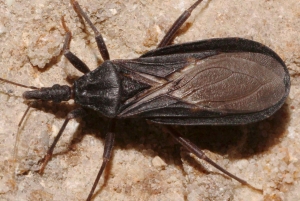Kissing Bugs

These pests are outside the authority of the Vector Control Program. We offer educational information but do not control or regulate these pests.
Conenose bugs or "kissing bugs" are members of the Reduviidae family, referred to as "assassin bugs." Most of the members of this family prey on insects, but kissing bugs are bloodsucking pests that prey on different wild animals and humans.
The Western Bloodsucking Conenose is found throughout the southwestern United States and Mexico. In California, they are found throughout the foothill areas. It is about 1/2" to 3/4" long and dark brown to black. It sometimes has a small tan edge around its abdominal region. The wings are held flat over the back at rest. The head has a 3-segmented beak that extends backward below the body.
Bites from kissing bugs normally occur at night while their prey are asleep. The bites appear as one or a few punctures about 1/4" apart in a straight line. The bite is usually painless, but may swell and itch for a couple of days. Fifty percent of people who get bit by the kissing bug will have a worse reaction the second time. Kissing bug bites are often confused with the bites of spiders and ticks.
Chagas Disease
Chagas disease is rare in San Diego County; there has never been a case reported that was acquired locally. It is most often reported in Latin America, where it is spread by a species of kissing bug not present in San Diego County. Our local species of kissing bug is a very poor vector of Chagas.
Chagas disease is spread through the droppings of kissing bugs, not by their bite. If the droppings get into bitten skin or into the eyes, it can enter the human body. Always clean bites with iodine to prevent infection and wash to remove the droppings.
Symptoms of the disease include swelling of the face, fever that develops two weeks after the bite, swelling of other areas, and sometimes nervous system disorders.
Prevention
You can control kissing bugs with these steps:
- Use weather stripping and caulking to close cracks and crevices
- Seal openings where bugs can get in
- Fix structural problems that allow entry
- Screen all windows and vents
- Insect-proof pet entrances
- Keep lights off at night by doors, windows and on patios when not needed
- Remove rodent nests, including wood rat middens, that are close to your home
- Remove firewood piles and debris
- Check beds at night and shake out bedding
- Keep beds a few inches away from the wall
Control
Chemical treatment should be a last resort. Remove hiding places and seal openings before you use chemicals. If you must use a chemical product, make sure to follow the directions on the label carefully. A total-release pyrethrin spray and insecticide dusts may help.
Kissing Bug photo by Lon & Queta




